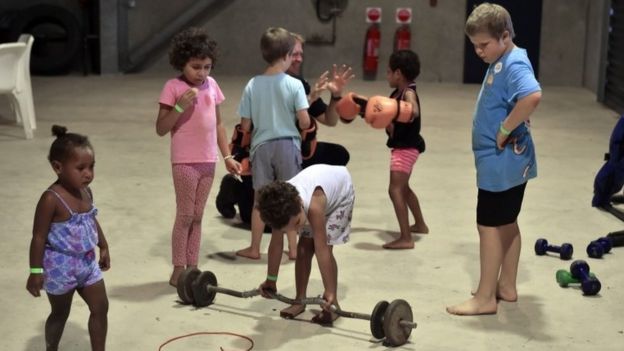A powerful cyclone has pummelled the north-east Australian coast, causing major damage, torrential rain and power cuts to tens of thousands of homes.
Cyclone Debbie made landfall between Bowen and Airlie Beach in Queensland as a category four storm, whipping gusts of up to 263km/h (163mph).
It is moving inland as a category two storm but could cause damage for hours yet.
Prime Minister Malcolm Turnbull said he was aware of one death so far.
Activating a disaster response plan, he stressed the picture could develop when emergency crews were able to assess the damage.
“Conditions have deteriorated rapidly,” he told parliament. “Take care and stay safe. Be prepared to shelter in place until Wednesday.”
Defence force helicopters and naval vessels would be sent to Queensland with aid, he added.
He said the Australian government would be urging insurance companies to be “compassionate” and supportive of people who have claims to make following the cyclone.
‘Battering ram effect’
The extent of Cyclone Debbie’s devastation, which has a 50km-diameter eye wall, may not be known for some time, the authorities said.
Queensland Police Commissioner Ian Stewart said the storm’s slow speed had created a “battering ram effect”, adding: “We are going to get lots of reports of damage, and sadly I think we will also receive reports of injuries, if not death.”
Queensland Premier Annastacia Palaszczuk said assessing damage was difficult because communities had been cut off from power and phone reception.
“Everyone is going to be in shock tomorrow, just to see the full impact of this cyclone,” she said. “I’m bracing myself for it.”

One man had been seriously injured in a wall collapse triggered by the storm in Proserpine, Mr Stewart said.
Electricity providers said it was not known when power would be restored to houses.
Officials warned people to stay indoors until it was safe to go outside.
Surfers condemned
The 1,500 residents of Collinsville inland were told to be aware the category two storm was heading for them.
“We’re going to see the impact of Cyclone Debbie for the next three to five days,” Ms Palaszczuk said.
She also condemned those people spotted surfing during the cyclone as “irresponsible” and “ridiculous”.
 Image copyrightAFP
Image copyrightAFPMore than 25,000 people were urged to evacuate their homes ahead of predictions the cyclone would be Queensland’s most damaging since 2011.
One person in the Whitsunday Islands compared the winds to “freight trains coming through left and right”.
“The trees are going wild,” the man, identified only as Charlie, told the Australian Broadcasting Corp. “The place is just shaking continuously.”
Greg Williamson, the mayor of Mackay regional council, told the BBC: “We’ve had winds up to about 95km/h for the last 12 hours. We’ve had torrential rain…. but that’s what you get for living in a tropical paradise.”
He said the Whitsunday Islands, Proserpine and Bowen were “really getting lashed now at the moment”.
In other key developments:
- The region is expected to be hit with 150-500mm of rain on Tuesday, with warnings of floods in low-lying areas
- Police warned people to beware of fallen power lines, which could be deadly
- Emergency stockpiles of food and fuel have been set aside, and the army is on standby
- The Insurance Council of Australia declared the cyclone a “catastrophe”
- David Wachenfeld, of the Great Barrier Reef Marine Park Authority, said he feared Debbie might have caused extensive damage to reefs in its path
More than 2,000 emergency workers are on standby but people have been warned crews will only respond when it is safe to do so.
 Image copyrightEPA
Image copyrightEPAAll flights have been cancelled at Townsville Airport and Mackay Airport.
Mr Stewart said the weather had contributed to the death of a woman in a car crash on Monday.
Cyclones and hurricanes: Different names for same thing
Why is it so powerful?
It made landfall at close to its peak intensity, Dr Jeffrey D Kepert, head of the Bureau of Meteorology’s High Impact Weather Research told the BBC. Crucially, it is also very slow-moving. That “can be more damaging because the duration of strong winds is longer. As structures experience a longer battering, things like metal fatigue set in, leading to more damage. Also, more of the rain falls in the same area rather than being spread out, leading to a greater flood risk”.
What is the predicted damage?
Fortunately Debbie looks likely to head between two cities so “the destruction is likely to be somewhat less than feared”. And while tourists are less able to evacuate from the resorts that have been hit more directly, their hotels are “likely to have higher foundations” and be built more solidly than many ordinary homes near the coast.
Panic over?
No. The storm will still be around even as it downgrades but, as a silver lining, it could bring some relief to farmers affected by drought. “Hopefully that will bring a bit of rain to the interior,” Professor King says.
More: Flinders University’s cyclone visualisation
Are you in the area? Have you been affected by this? If you are willing to do so, share with us by emailing [email protected].
Please include a contact number if you are willing to speak to a BBC journalist. You can also contact us in the following ways:
